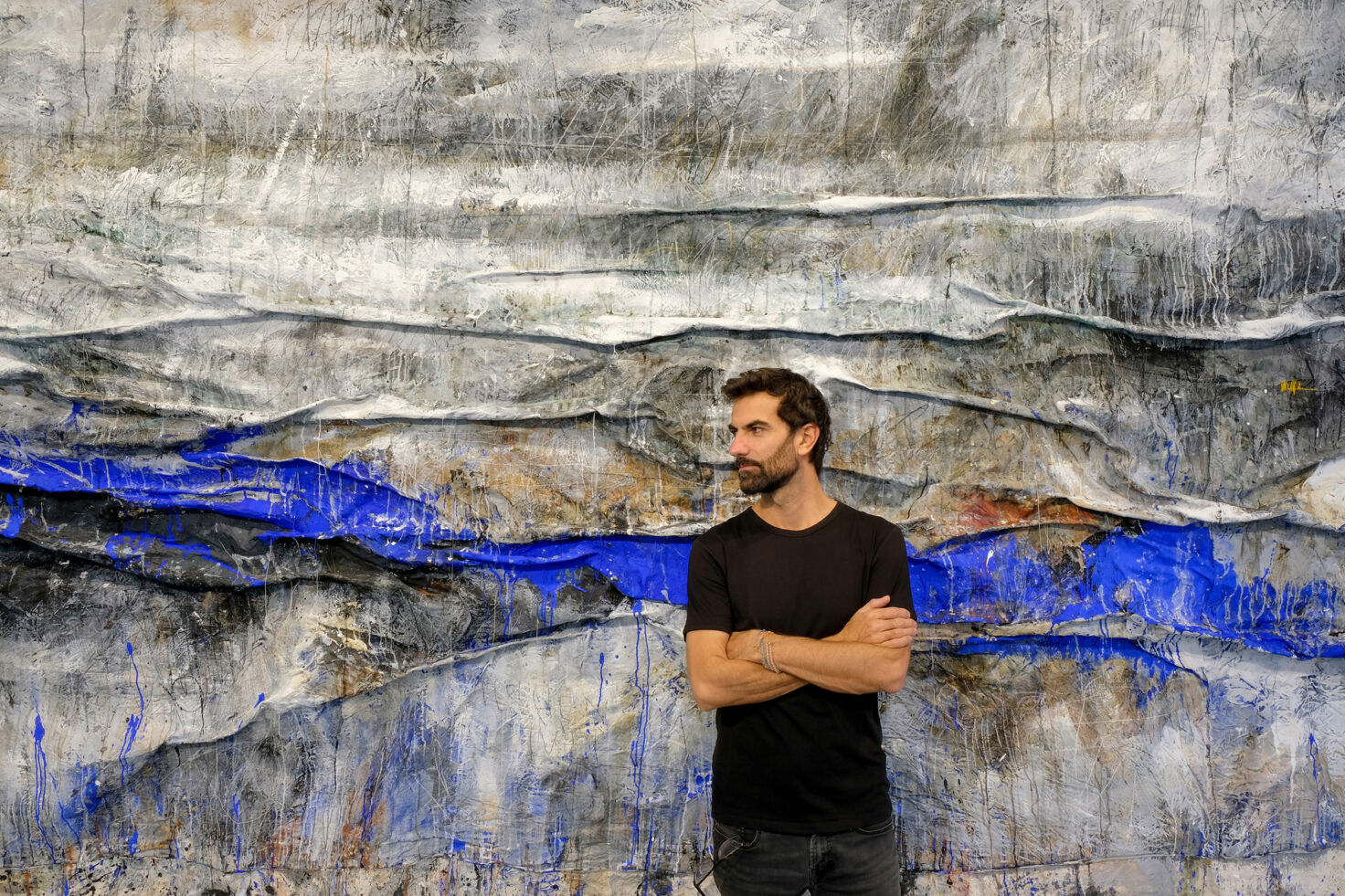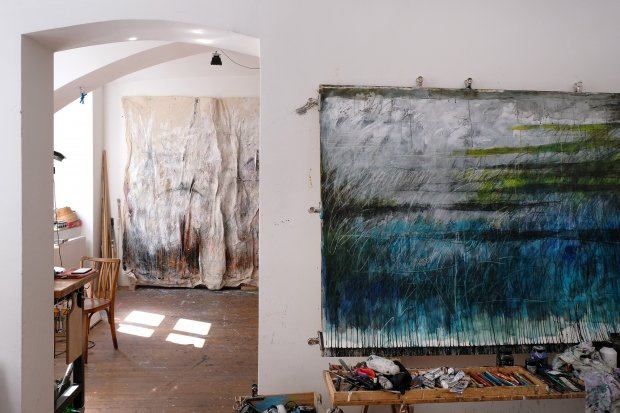
Artist
Born into the third generation of a family of artists in 1975, Jakob Kirchmayr explored the fields of drawing, before developing his own style and unique expression as a painter. After graduating from the Academy of Fine Arts in Vienna, he established his own studio in the fourth district, a melting pot of the city‘s fine art galleries, artists and the creative scene of the city.
Starting out with figurative painting in his earlier work, Jakob Kirchmayr reveals an astonishing understanding of the human condition. Major shifts and transformations in his life, induced a radical change in his approach and his style boldly evolved towards abstraction and a new freedom of expression in recent years.
Inspired by lyrical texts, his visually compelling compositions are filled with layers of meaning. Handwritten quotes appear like hidden messages in his art, inviting the audience to discover them at a second glance. Evolving from landscape, Kirchmayr‘s latest work is mostly liberated from an obvious subject. Going further, the artist doesn’t just use landscapes as metaphors for and projections of his own experiences, his various topographies are portraits of collective memories that evoke an emotional response in the viewer.1
The artist‘s sensibility towards the haptic quality of his materials becomes apparent in his monumental works on paper and canvas. Building layer upon layer of colour and texture, Kirchmayr rejects working with preliminary sketches. Thus, his paintings are filled with the strongest vitality, as the artist follows his impulses with a dynamic and spontaneous way of painting.
The secret to the brilliance and lucidity of colours in his works on paper lies in his choice of purest pigments and a special technique, developed by the artist through years of experimenting. Choosing French cotton paper of the highest quality, Kirchmayr allows his paintings to bend and build waves under the weight and humidity of ink, pigment, gesso and acrylic, adding a further dimension to his art. Instead of being pressed and straightened out, his papers are filled with their own life and an astonishing presence. Emphasizing the contrast of the fragility of his works on paper with their apparent solidity, Jakob Kirchmayr creates hand made frames of natural oak without glass, that would separate the work from the viewer, conveying a sense of immediacy and an impression of three-dimensionality.
Jakob Kirchmayr‘s work has been exhibited in major solo shows, group exhibitions within Austria and Europe and art fairs within Europe and the USA in collaboration with the renowned Austrian Galerie Ernst Hilger, among others.The artist lives and works in Vienna, Austria.
1) Erwin Uhrmann, „The earth tastes different wherever you go", 2019
A GLIMPSE OF MEMORY AND TIME
Text: Angelika Seebacher
A Glimpse of Memory and Time – a thought, flaring up like a flash from the past, or a sensation that suddenly and very intensely asserts its presence: this is how the creative process of Jakob Kirchmayr typically begins. There is hardly ever one specific idea when he tackles a new painting. Rather, it is a continuous tracking of a sense, along with different external influences and the poetry of Yiannis Ritsos, which for years has served as a source of inspiration for the artist.
Jakob Kirchmayr’s artistic lineage dates back three generations. His roots are in Tyrol, Austria, and the time spent in nature and the mountains had a lasting impact that still reverberates in his art today. As Kirchmayr puts it, “the world in which I grew up in was archaic, influenced by my father’s unquenchable thirst for adventure.” He associates colours and scents with strong emotions and memories from his childhood. Memories of numerous travels to Greece with his family, still prior to sweeping environmental transgressions and before mass tourism had fully established its destructive force. Over the years, Kirchmayr has watched the steady retreat of unspoilt nature and the ever increasing scale of its pollution. In the light of global abuses and the ruthlessness of the system that we live in, touches of melancholy, sadness, and anger gradually began to set in.
In this regard, the artist was particularly affected by a letter of Ritsos to his brother in 1950, in which the Greek poet describes the extreme injustice and unutterable violence suffered by himself and thousands of other political prisoners banished to so-called “internal exile” on various smaller Greek islands. People, whose only crime was to fight for freedom and peace. Many passages of Ritsos’s writings are directly adaptable to the present situation with its everyday human rights violations; his language, rich in contextual references and imagery, not infrequently has the effect of a shocking déjà vu.
All these elements blend into Kirchmayr’s multi-layered, monumental works, which are currently developed on handmade paper from Nepal, which inherently contains a vivid, distinctive structure. Following an impulse, without preliminary sketches or planning, something slowly emerges during the often prolonged work process from the initially completely abstract painting. Something that might be reminiscent of seemingly mythic, rugged, rocky landscapes, whose many facets, shades, and depths reflect the artist’s inner world. On the one hand representive of the metaphors and projections of Kirchmayr, these paintings might also tempt the viewer to interpret them as a portrait of the collective state of mind at the time of their creation.
Between the dense, interlocking layers of paint, the semiotic and written elements, at once delicate and expressive and attributable to a downright catharsis of the artist, intense and distinctive lucid intervals appear throughout. Bright blues, a tiny spark of orange, and the consistently present, shimmering white periodically contribute to the fascinating balance and powerful attraction of Jakob Kirchmayr’s profound paintings –and this, in turn, may also be adapted for the bigger picture.

JAKOB KIRCHMAYR – STUDIO DIARY (German language)
In einer Zeit allgemeiner Einschränkungen, gewährt das Kunstmagazin PARNASS, Einblicke in Künstlerateliers – so auch in mein Studio.